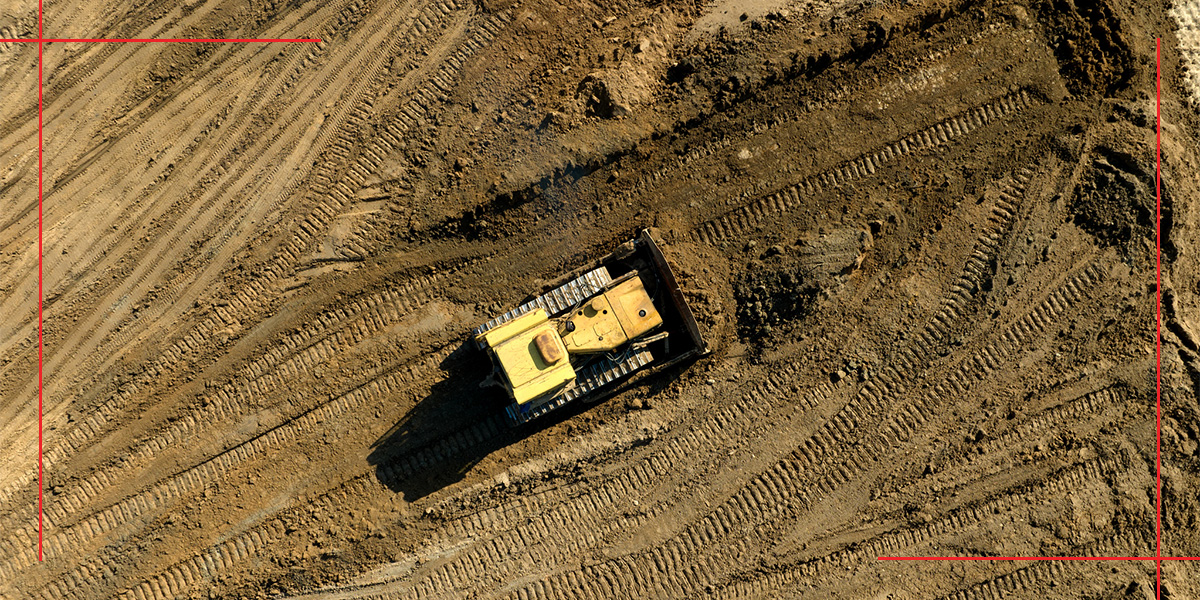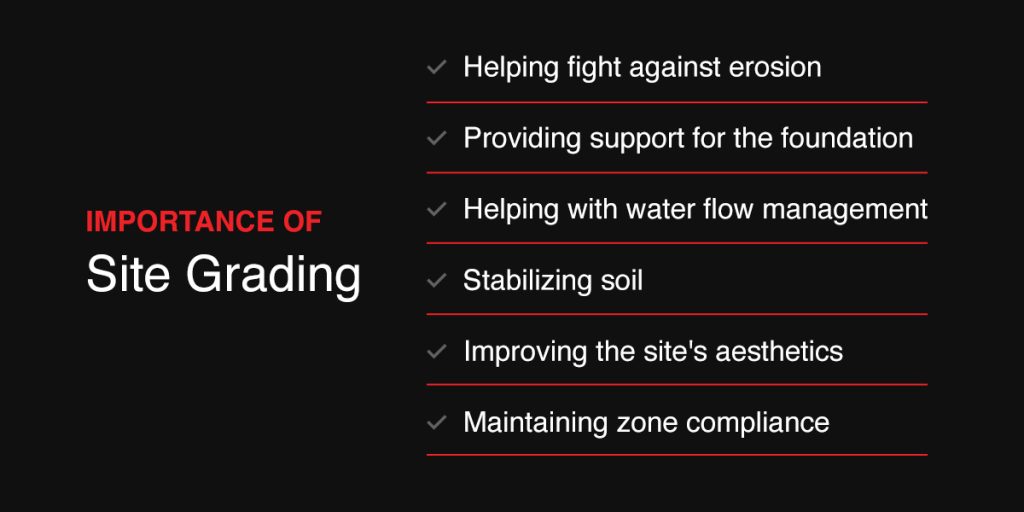Construction Grading Guide

07/15/2025
What Is Construction Grading?
Grading is among the most critical steps in construction and involves laying the foundation for a stable building. In this quick guide, we walk you through the basics of construction grading, including what it is, its importance and the different types.
What Does Grading Mean in Construction?
Grading in construction aims to create a stable surface that supports buildings, controls water drainage and prevents erosion. It involves adjusting an area’s contours and slope by taking soil from higher areas and adding it to lower ones. It could also make the soil denser, preventing it from shifting over time.
Construction Grading Types and Purposes
Depending on a construction site’s needs, the project’s optimal execution may require different types of site grading. Here are six types of construction grading strategies that may occur on a site.
1. Landscape Grading
Landscape grading helps prepare a site for a landscaping project by removing topsoil, smoothing areas for planting and making the area more aesthetically appealing. Typically, landscape graders also install or create an irrigation system. By reshaping the land to make elevation changes, construction professionals can facilitate water drainage to a specific area.
Landscape projects have water drainage requirements because pooling can damage plant life. Poor water drainage flow may also prevent some plants from getting the water they need to survive, and dying landscapes are much less aesthetically appealing.
2. Architectural Grading
Architectural grading changes the shape of the land for a new building project, whether it be a new home, housing development or commercial property. This process removes elevations that may permit water to drain in areas that could damage the future structure.
3. Regrading
Regrading is the process of lowering or raising the project area. Whether you’re working on a large development or a small project, regrading allows the structure to sit on a level area that allows for sufficient water drainage and ensures the building is on secure ground.
4. Rough Grading
Rough grading shapes the construction site set to provide a base for turf development. Setting a slope and leveling an area both fall under rough grading, and these processes ensure water drains effectively. While performing rough grading, workers adjust an area’s natural shape and elevation by adding, removing or relocating topsoil.
5. Finished Grading
Finished grading puts the final touches on the site. At this stage, workers remove rocks, lumps of soil and any other debris that may inhibit plant growth or make the surface uneven. Finished grading creates a uniform layer of materials across the site that a roller may go over to harden and flatten.
6. Final Grading
Final grading in construction is the last step in the construction site grading process. During this stage, workers place a layer of sand or topsoil that promotes growth. Then, the final landscaping process can begin, placing plants and landscaping materials in their designated areas. Final grading also prepares a site for seeding and ensures adequate water drainage and promotes growth.
Site Grading Plan Elevations
Many municipalities have regulations requiring construction companies to create and submit a site grading plan before beginning the process. A city department must inspect and approve these plans in advance.
Site grading plans offer a three-dimensional portrayal of the site and its elevations. The contour lines depict how gentle or steep a slope is. Grading plans also include information about what is already on the site, including trees, drainage lines, and power or utility lines.
These site grading plans confirm that the grading and resulting elevations will provide proper drainage. Planning officials consider three primary factors.
1. Lot Size and Structure Coverage
Many areas define the maximum amount of space a structure can cover on a lot. The coverage percentage tells reviewers whether the plan meets the building requirements.
2. Earthwork Estimates
The site grading plan must include the amount of earthwork used in a project. Earthwork is artificial material used to cut or fill work, and the reviewer must know how much material the construction crew will bring to or remove from the site.
3. Property Lines
Property lines are essential to consider before grading and building. Utility lines also impact where grading can occur, as they are easy to damage.
Importance of Site Grading
Grading has many benefits for construction, including:
- Helping fight against erosion: Erosion is a serious problem in construction because it can lead to uneven surfaces and soil displacement. Grading helps fight erosion by controlling the water flow across the land.
- Providing support for the foundation: Grading creates a stable base for building foundations. It ensures buildings are supported evenly, curbing structural issues resulting from imbalances.
- Helping with water flow management: Grading helps channel water away from structures, preventing issues like flooding, water pooling and foundational damage.
- Stabilizing soil: Site grading helps stabilize soil and reduces the chances of it moving under the structure. This is helpful in places with loose or clay soil that can affect the foundation’s integrity.
- Improving the site’s aesthetics: A smooth landing makes the finished structure look better.
- Maintaining zone compliance: Because improper draining can lead to issues like water runoff, many areas have strict rules for compliance.
Frequently Asked Questions About Construction Grading
Still have questions about construction grading? Find answers below.
Is Grading the Same as Leveling?
Not exactly. Leveling involves smoothing the land out, while grading involves carving the land into shapes that match the drainage plan or blueprint.
Can Property Owners Grade Their Own Property?
Some property owners may grade their own yards if the fixes are small. However, if the project is large, the slope is intense or there are many obstacles in the way, it’s best to leave grading to the professionals.
What Is the Difference Between Finished Grading and Final Grading?
Finished grading occurs toward the end of the process and involves removing debris and putting other finishing touches on the land. Final grading in construction is the last step. It involves preparing land for landscaping by adding and compacting sand or topsoil where necessary.
What Does a Grading Plan Mean in Construction?
A grading plan highlights how construction workers will redirect surface water runoff from structures and what equipment they will use.
Building on Experience, Building With Integrity
To ensure a successful building project from start to finish, it’s essential to choose a trustworthy, experienced partner. At JRM Construction Management, we offer thorough preconstruction and careful on-site construction management services. Our teamwork guarantees accountability, sustainability and safety, with a culture of collaboration that promotes effective time management and a job well done.
When you want realistic project estimates and timelines, you can trust JRM. We understand that construction projects are complex and multifaceted, which is why we remain dedicated to keeping you informed of all developments and updates. Contact our team today to discuss your next project.




)